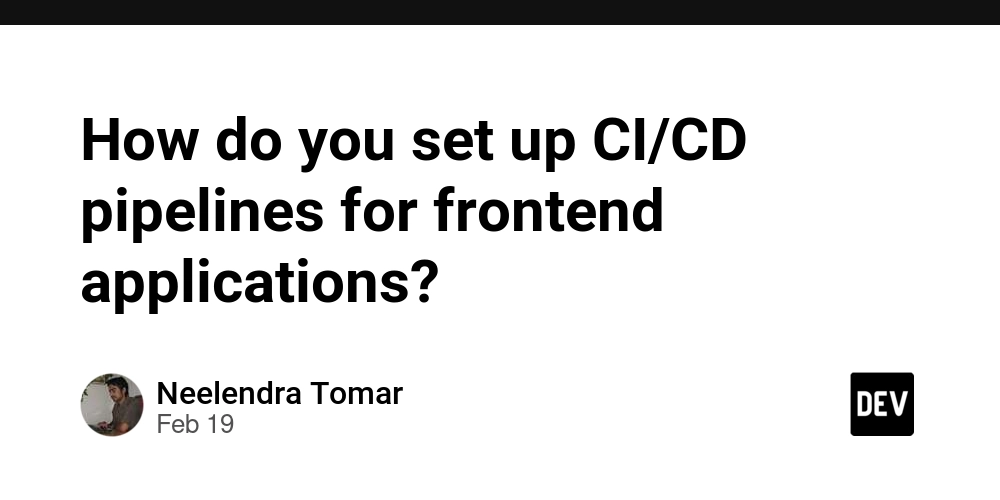How do you set up CI/CD pipelines for frontend applications?
Setting up a CI/CD pipeline for frontend applications involves automating the process of building, testing, and deploying your application. Here’s a step-by-step guide to setting up a CI/CD pipeline for your Next.js PWA project: 1. Choose a CI/CD Provider You can use: GitHub Actions (built into GitHub) GitLab CI/CD CircleCI Travis CI Jenkins Bitbucket Pipelines For Next.js projects, GitHub Actions is a great choice due to its deep integration with Vercel, Netlify, or custom deployments. 2. Set Up CI/CD Pipeline Step 1: Define Your Workflow (GitHub Actions Example) Create a .github/workflows/ci-cd.yml file: name: CI/CD Pipeline on: push: branches: - main pull_request: branches: - main jobs: build-test: runs-on: ubuntu-latest steps: - name: Checkout Code uses: actions/checkout@v3 - name: Install Node.js uses: actions/setup-node@v3 with: node-version: 18 cache: 'npm' - name: Install Dependencies run: npm install - name: Run Linting run: npm run lint - name: Run Tests run: npm test - name: Build Project run: npm run build deploy: needs: build-test runs-on: ubuntu-latest steps: - name: Deploy to Vercel uses: amondnet/vercel-action@v25 with: vercel-token: ${{ secrets.VERCEL_TOKEN }} vercel-org-id: ${{ secrets.VERCEL_ORG_ID }} vercel-project-id: ${{ secrets.VERCEL_PROJECT_ID }} Step 2: Configure Secrets In GitHub → Repo Settings → Secrets, add: VERCEL_TOKEN VERCEL_ORG_ID VERCEL_PROJECT_ID Step 3: Automate Deployments Deploy Options: Vercel (Recommended for Next.js) Just connect GitHub, and it auto-deploys. Netlify (For JAMstack deployments) AWS S3 + CloudFront (For static sites) Firebase Hosting (For PWAs) Docker + Kubernetes (For advanced setups) For Docker-based deployments, you can use: - name: Build Docker Image run: docker build -t my-frontend-app . - name: Push to Docker Hub run: docker push my-frontend-app 3. Implement Monitoring & Rollbacks Monitoring Use Sentry, Datadog, or LogRocket for error tracking. Use New Relic for real-time monitoring. Rollback Strategy Keep previous builds in Vercel/Netlify for easy rollbacks. Use GitHub Tags to tag stable releases (v1.0.0). Automate rollback if deployment fails (e.g., npm run rollback). 4. Enhancements Parallelization Speed up pipelines by running tests in parallel: strategy: matrix: node: [16, 18] runs-on: ubuntu-latest Cache Dependencies Reduce build time by caching node_modules: - name: Cache Dependencies uses: actions/cache@v3 with: path: ~/.npm key: ${{ runner.os }}-node-${{ hashFiles('**/package-lock.json') }} restore-keys: | ${{ runner.os }}-node- Final Thoughts For Next.js PWAs, Vercel or Netlify provides the easiest deployments. Use GitHub Actions or GitLab CI/CD for smooth automation. Add monitoring + rollbacks for reliability.

Setting up a CI/CD pipeline for frontend applications involves automating the process of building, testing, and deploying your application. Here’s a step-by-step guide to setting up a CI/CD pipeline for your Next.js PWA project:
1. Choose a CI/CD Provider
You can use:
- GitHub Actions (built into GitHub)
- GitLab CI/CD
- CircleCI
- Travis CI
- Jenkins
- Bitbucket Pipelines
For Next.js projects, GitHub Actions is a great choice due to its deep integration with Vercel, Netlify, or custom deployments.
2. Set Up CI/CD Pipeline
Step 1: Define Your Workflow (GitHub Actions Example)
Create a .github/workflows/ci-cd.yml file:
name: CI/CD Pipeline
on:
push:
branches:
- main
pull_request:
branches:
- main
jobs:
build-test:
runs-on: ubuntu-latest
steps:
- name: Checkout Code
uses: actions/checkout@v3
- name: Install Node.js
uses: actions/setup-node@v3
with:
node-version: 18
cache: 'npm'
- name: Install Dependencies
run: npm install
- name: Run Linting
run: npm run lint
- name: Run Tests
run: npm test
- name: Build Project
run: npm run build
deploy:
needs: build-test
runs-on: ubuntu-latest
steps:
- name: Deploy to Vercel
uses: amondnet/vercel-action@v25
with:
vercel-token: ${{ secrets.VERCEL_TOKEN }}
vercel-org-id: ${{ secrets.VERCEL_ORG_ID }}
vercel-project-id: ${{ secrets.VERCEL_PROJECT_ID }}
Step 2: Configure Secrets
- In GitHub → Repo Settings → Secrets, add:
VERCEL_TOKENVERCEL_ORG_IDVERCEL_PROJECT_ID
Step 3: Automate Deployments
Deploy Options:
-
Vercel (Recommended for Next.js)
- Just connect GitHub, and it auto-deploys.
- Netlify (For JAMstack deployments)
- AWS S3 + CloudFront (For static sites)
- Firebase Hosting (For PWAs)
- Docker + Kubernetes (For advanced setups)
For Docker-based deployments, you can use:
- name: Build Docker Image
run: docker build -t my-frontend-app .
- name: Push to Docker Hub
run: docker push my-frontend-app
3. Implement Monitoring & Rollbacks
Monitoring
- Use Sentry, Datadog, or LogRocket for error tracking.
- Use New Relic for real-time monitoring.
Rollback Strategy
- Keep previous builds in Vercel/Netlify for easy rollbacks.
- Use GitHub Tags to tag stable releases (
v1.0.0). - Automate rollback if deployment fails (e.g.,
npm run rollback).
4. Enhancements
Parallelization
Speed up pipelines by running tests in parallel:
strategy:
matrix:
node: [16, 18]
runs-on: ubuntu-latest
Cache Dependencies
Reduce build time by caching node_modules:
- name: Cache Dependencies
uses: actions/cache@v3
with:
path: ~/.npm
key: ${{ runner.os }}-node-${{ hashFiles('**/package-lock.json') }}
restore-keys: |
${{ runner.os }}-node-
Final Thoughts
- For Next.js PWAs, Vercel or Netlify provides the easiest deployments.
- Use GitHub Actions or GitLab CI/CD for smooth automation.
- Add monitoring + rollbacks for reliability.










































































































































































![[The AI Show Episode 142]: ChatGPT’s New Image Generator, Studio Ghibli Craze and Backlash, Gemini 2.5, OpenAI Academy, 4o Updates, Vibe Marketing & xAI Acquires X](https://www.marketingaiinstitute.com/hubfs/ep%20142%20cover.png)



























































































































![[FREE EBOOKS] The Kubernetes Bible, The Ultimate Linux Shell Scripting Guide & Four More Best Selling Titles](https://www.javacodegeeks.com/wp-content/uploads/2012/12/jcg-logo.jpg)



![From drop-out to software architect with Jason Lengstorf [Podcast #167]](https://cdn.hashnode.com/res/hashnode/image/upload/v1743796461357/f3d19cd7-e6f5-4d7c-8bfc-eb974bc8da68.png?#)






































































































.png?#)




.jpg?#)































_Christophe_Coat_Alamy.jpg?#)








































































































![Rapidus in Talks With Apple as It Accelerates Toward 2nm Chip Production [Report]](https://www.iclarified.com/images/news/96937/96937/96937-640.jpg)









































































































































